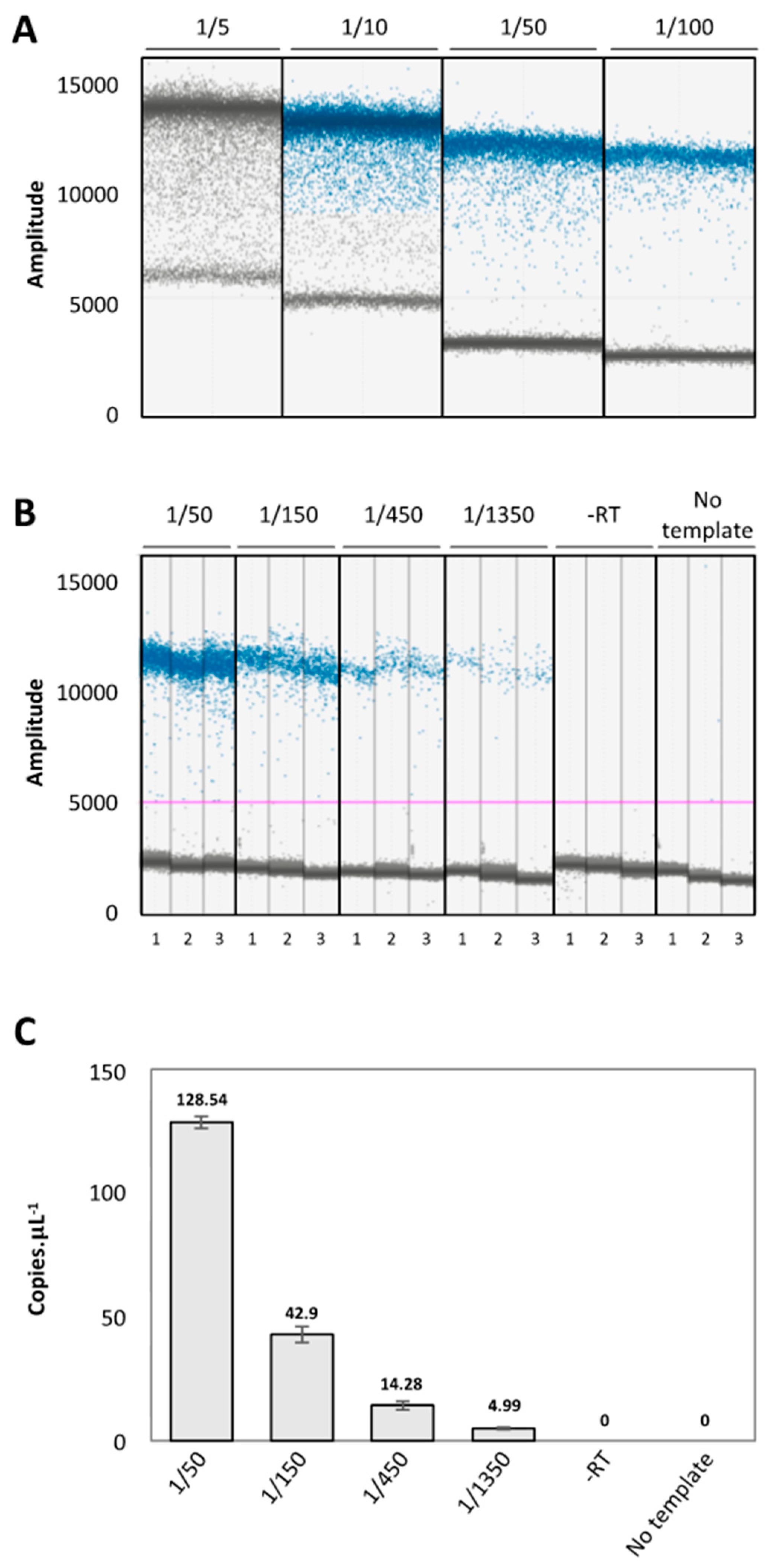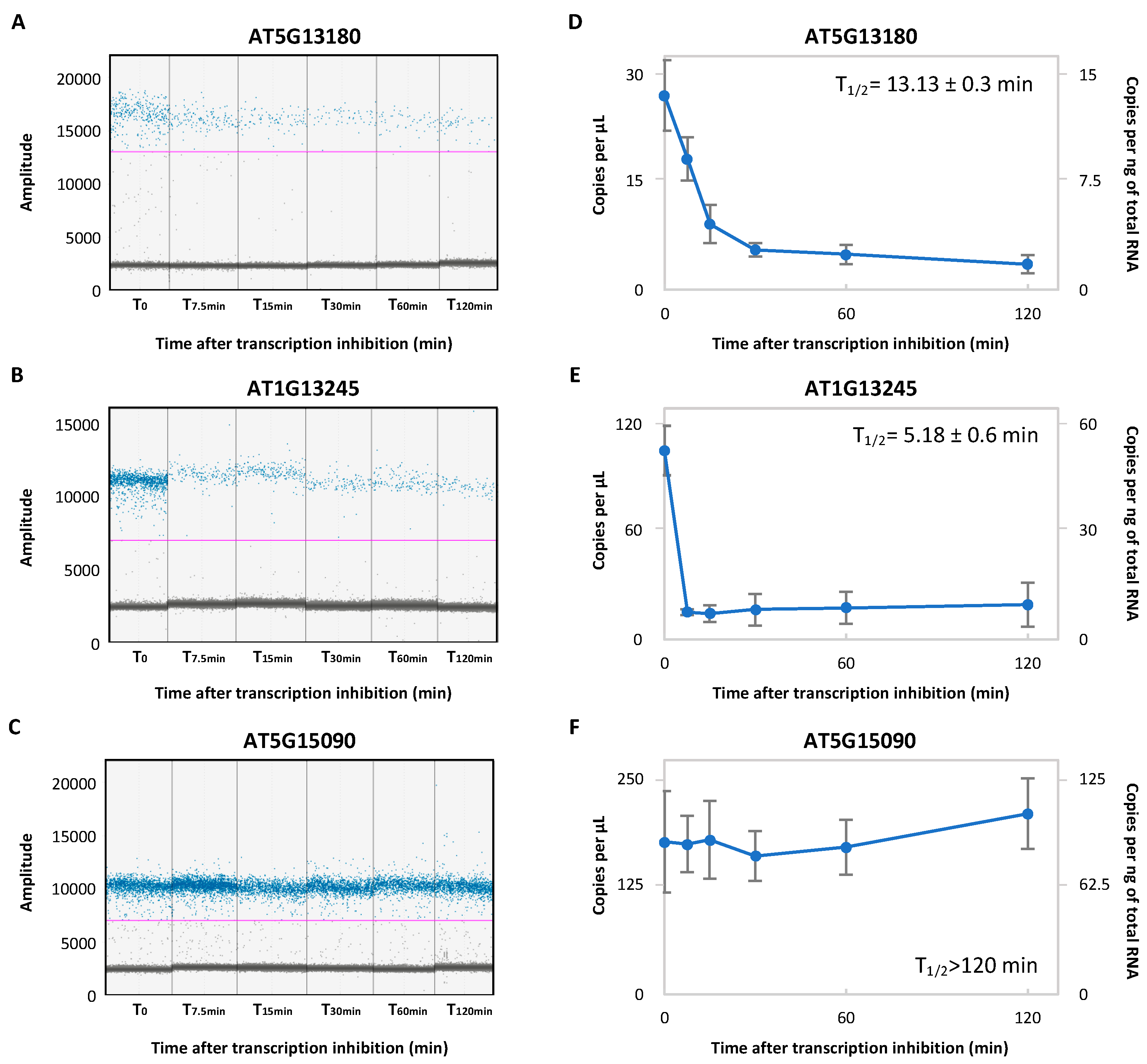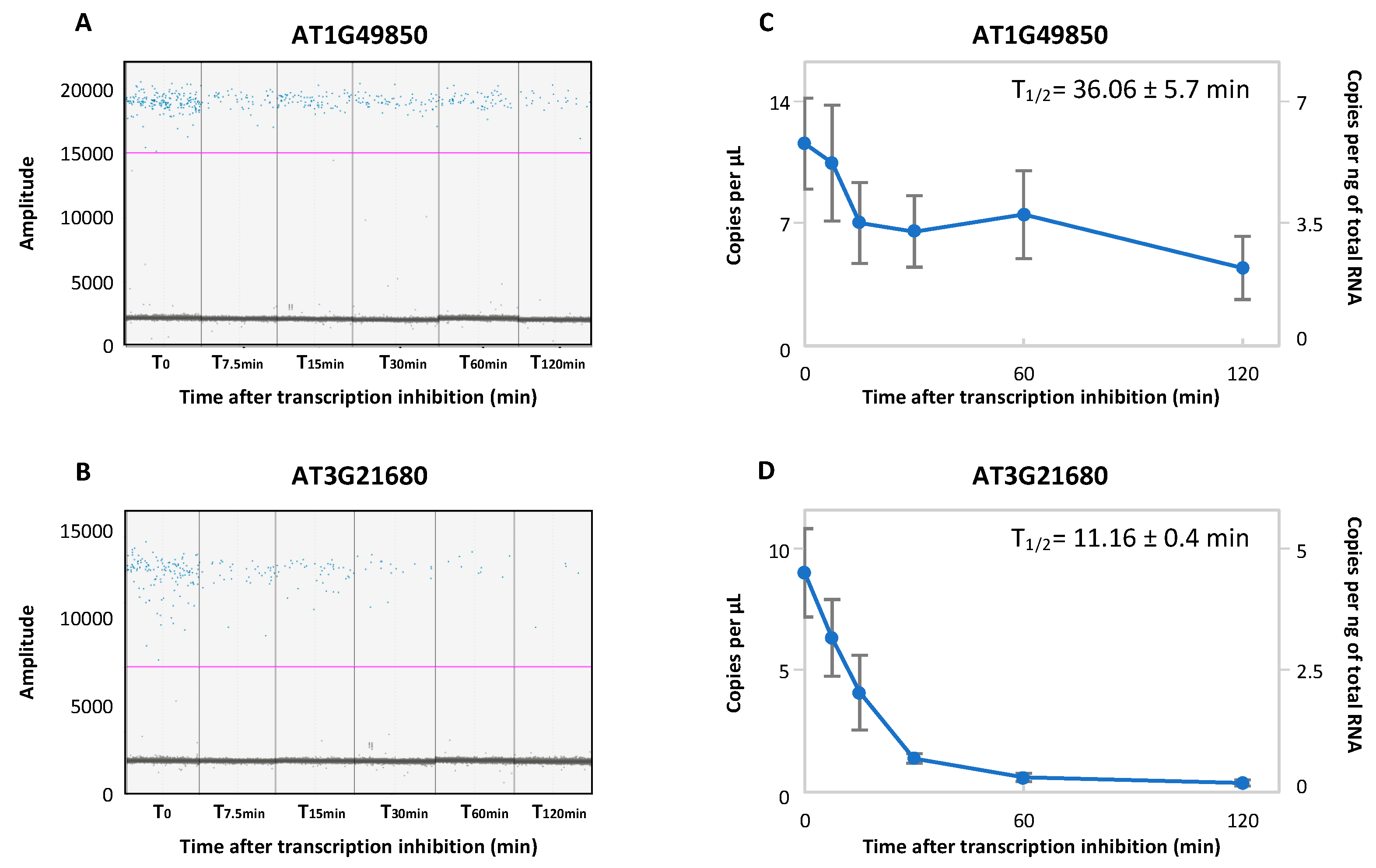Monitoring mRNA Half-Life in Arabidopsis Using Droplet Digital PCR
Abstract
1. Introduction
2. Results
2.1. Determination of Optimal Conditions for ddPCR Quantification
2.2. ddPCR Technology Allows an Accurate Determination of mRNA Half-Life
2.3. Multiplexing Assay Allows Determination of mRNA Half-Life of Distinct Transcripts in a Single Reaction
2.4. Characterization of mRNA Half-Life of Lowly Expressed Transcripts
3. Discussion
4. Materials and Methods
4.1. Growth Condition and Transcription Inhibition
4.2. RNA Extraction and Reverse-Transcription
4.3. Primer Design
4.4. ddPCR Reaction
4.5. mRNA Half-Life Determination
Supplementary Materials
Author Contributions
Funding
Data Availability Statement
Acknowledgments
Conflicts of Interest
References
- Sieburth, L.E.; Vincent, J.N. Beyond transcription factors: Roles of mrna decay in regulating gene expression in plants [version 1; referees: 3 approved]. F1000Research 2018, 7, 1–10. [Google Scholar] [CrossRef] [PubMed]
- Pelechano, V.; Wei, W.; Steinmetz, L.M. Widespread co-translational RNA decay reveals ribosome dynamics. Cell 2015, 161, 1400–1412. [Google Scholar] [CrossRef] [PubMed]
- Carpentier, M.C.; Deragon, J.M.; Jean, V.; Seng Hour Vichet, B.; Bousquet-Antonelli, C.; Merret, R. Monitoring of XRN4 targets reveals the importance of cotranslational decay during arabidopsis development. Plant Physiol. 2020, 184, 1251–1262. [Google Scholar] [CrossRef] [PubMed]
- Tuck, A.C.; Rankova, A.; Arpat, A.B.; Liechti, L.A.; Hess, D.; Iesmantavicius, V.; Castelo-Szekely, V.; Gatfield, D.; Bühler, M. Mammalian RNA Decay Pathways Are Highly Specialized and Widely Linked to Translation. Mol. Cell 2020, 77, 1222–1236.e13. [Google Scholar] [CrossRef] [PubMed]
- Chan, L.Y.; Mugler, C.F.; Heinrich, S.; Vallotton, P.; Weis, K. Non-invasive measurement of mRNA decay reveals translation initiation as the major determinant of mRNA stability. Elife 2018, 7, e32536. [Google Scholar] [CrossRef]
- Sorenson, R.S.; Deshotel, M.J.; Johnson, K.; Adler, F.R.; Sieburth, L.E. Arabidopsis mRNA decay landscape arises from specialized RNA decay substrates, decapping-mediated feedback, and redundancy. Proc. Natl. Acad. Sci. USA 2018, 115, E1485–E1494. [Google Scholar] [CrossRef]
- Szabo, E.X.; Reichert, P.; Lehniger, M.K.; Ohmer, M.; de Francisco Amorim, M.; Gowik, U.; Schmitz-Linneweber, C.; Laubinger, S. Metabolic labeling of RNAs uncovers hidden features and dynamics of the arabidopsis transcriptome [CC-BY]. Plant Cell 2020, 32, 871–887. [Google Scholar] [CrossRef]
- Merret, R.; Descombin, J.; Juan, Y.T.; Favory, J.J.; Carpentier, M.C.; Chaparro, C.; Charng, Y.Y.; Deragon, J.M.; Bousquet-Antonelli, C. XRN4 and LARP1 are required for a heat-triggered mRNA decay pathway involved in plant acclimation and survival during thermal stress. Cell Rep. 2013, 5, 1279–1293. [Google Scholar] [CrossRef]
- Chiba, Y.; Mineta, K.; Hirai, M.Y.; Suzuki, Y.; Kanaya, S.; Takahashi, H.; Onouchi, H.; Yamaguchi, J.; Naito, S. Changes in mRNA Stability Associated with Cold Stress in Arabidopsis Cells. Plant Cell Physiol. 2013, 54, 180–194. [Google Scholar] [CrossRef]
- Romero-Santacreu, L.; Moreno, J.; Pérez-Ortín, J.E.; Alepuz, P. Specific and global regulation of mRNA stability during osmotic stress in Saccharomyces cerevisiae. RNA 2009, 15, 1110–1120. [Google Scholar] [CrossRef]
- Bensaude, O. Inhibiting eukaryotic transcription: Which compound to choose? How to evaluate its activity? Transcription 2011, 2, 103–108. [Google Scholar] [CrossRef] [PubMed]
- Hindson, C.M.; Chevillet, J.R.; Briggs, H.A.; Gallichotte, E.N.; Ruf, I.K.; Hindson, B.J.; Vessella, R.L.; Tewari, M. Absolute quantification by droplet digital PCR versus analog real-time PCR. Nat. Methods 2013, 10, 1003–1005. [Google Scholar] [CrossRef] [PubMed]
- Bell, A.D.; Usher, C.L.; McCarroll, S.A. Analyzing Copy Number Variation with Droplet Digital PCR BT. In Digital PCR: Methods and Protocols; Karlin-Neumann, G., Bizouarn, F., Eds.; Springer New York: New York, NY, USA, 2018; pp. 143–160. ISBN 978-1-4939-7778-9. [Google Scholar]
- Parkin, B. Rare Variant Quantitation Using Droplet Digital PCR BT. In Chronic Lymphocytic Leukemia: Methods and Protocols; Malek, S.N., Ed.; Springer New York: New York, NY, USA, 2019; pp. 239–251. ISBN 978-1-4939-8876-1. [Google Scholar]
- Preobrazhenskaya, E.V.; Bizin, I.V.; Kuligina, E.S.; Shleykina, A.Y.; Suspitsin, E.N.; Zaytseva, O.A.; Anisimova, E.I.; Laptiev, S.A.; Gorodnova, T.V.; Belyaev, A.M.; et al. Detection of BRCA1 gross rearrangements by droplet digital PCR. Breast Cancer Res. Treat. 2017, 165, 765–770. [Google Scholar] [CrossRef] [PubMed]
- Gutiérrez-Aguirre, I.; Rački, N.; Dreo, T.; Ravnikar, M. Droplet Digital PCR for Absolute Quantification of Pathogens BT. In Plant Pathology: Techniques and Protocols; Lacomme, C., Ed.; Springer New York: New York, NY, USA, 2015; pp. 331–347. ISBN 978-1-4939-2620-6. [Google Scholar]
- Pharo, H.D.; Andresen, K.; Berg, K.C.G.; Lothe, R.A.; Jeanmougin, M.; Lind, G.E. A robust internal control for high-precision DNA methylation analyses by droplet digital PCR. Clin. Epigenetics 2018, 10, 24. [Google Scholar] [CrossRef] [PubMed]
- Whale, A.S.; Huggett, J.F.; Tzonev, S. Fundamentals of multiplexing with digital PCR. Biomol. Detect. Quantif. 2016, 10, 15–23. [Google Scholar] [CrossRef] [PubMed]
- Chantarachot, T.; Sorenson, R.S.; Hummel, M.; Ke, H.; Kettenburg, A.T.; Chen, D.; Aiyetiwa, K.; Dehesh, K.; Eulgem, T.; Sieburth, L.E.; et al. DHH1/DDX6-like RNA helicases maintain ephemeral half-lives of stress-response mRNAs. Nat. Plants 2020, 6, 675–685. [Google Scholar] [CrossRef]
- Kawa, D.; Meyer, A.J.; Dekker, H.L.; Abd-El-Haliem, A.M.; Gevaert, K.; Van De Slijke, E.; Maszkowska, J.; Bucholc, M.; Dobrowolska, G.; De Jaeger, G.; et al. SnRK2 Protein Kinases and mRNA Decapping Machinery Control Root Development and Response to Salt. Plant Physiol. 2020, 182, 361–377. [Google Scholar] [CrossRef]
- Tong, J.; Ren, Z.; Sun, L.; Zhou, S.; Yuan, W.; Hui, Y.; Ci, D.; Wang, W.; Fan, L.-M.; Wu, Z.; et al. ALBA proteins confer thermotolerance through stabilizing HSF messenger RNAs in cytoplasmic granules. Nat. Plants 2022, 8, 778–791. [Google Scholar] [CrossRef]
- Nagarajan, V.K.; Kukulich, P.M.; von Hagel, B.; Green, P.J. RNA degradomes reveal substrates and importance for dark and nitrogen stress responses of Arabidopsis XRN4. Nucleic Acids Res. 2019, 47, 9216–9230. [Google Scholar] [CrossRef]
- Taylor, S.C.; Laperriere, G.; Germain, H. Droplet Digital PCR versus qPCR for gene expression analysis with low abundant targets: From variable nonsense to publication quality data. Sci. Rep. 2017, 7, 2409. [Google Scholar] [CrossRef]
- Ramírez, J.D.; Herrera, G.; Hernández, C.; Cruz-Saavedra, L.; Muñoz, M.; Flórez, C.; Butcher, R. Evaluation of the analytical and diagnostic performance of a digital droplet polymerase chain reaction (ddPCR) assay to detect Trypanosoma cruzi DNA in blood samples. PLoS Negl. Trop. Dis. 2018, 12, e0007063. [Google Scholar] [CrossRef] [PubMed]
- Tang, H.; Cai, Q.; Li, H.; Hu, P. Comparison of droplet digital PCR to real-time PCR for quantification of hepatitis B virus DNA. Biosci. Biotechnol. Biochem. 2016, 80, 2159–2164. [Google Scholar] [CrossRef] [PubMed]
- Villamil, C.; Calderon, M.N.; Arias, M.M.; Leguizamon, J.E. Validation of Droplet Digital Polymerase Chain Reaction for Salmonella spp. Quantification. Front. Microbiol. 2020, 11, 1512. [Google Scholar] [CrossRef] [PubMed]
- Svec, D.; Tichopad, A.; Novosadova, V.; Pfaffl, M.W.; Kubista, M. How good is a PCR efficiency estimate: Recommendations for precise and robust qPCR efficiency assessments. Biomol. Detect. Quantif. 2015, 3, 9–16. [Google Scholar] [CrossRef] [PubMed]
- Taylor, S.C.; Nadeau, K.; Abbasi, M.; Lachance, C.; Nguyen, M.; Fenrich, J. The Ultimate qPCR Experiment: Producing Publication Quality, Reproducible Data the First Time. Trends Biotechnol. 2019, 37, 761–774. [Google Scholar] [CrossRef]




Publisher’s Note: MDPI stays neutral with regard to jurisdictional claims in published maps and institutional affiliations. |
© 2022 by the authors. Licensee MDPI, Basel, Switzerland. This article is an open access article distributed under the terms and conditions of the Creative Commons Attribution (CC BY) license (https://creativecommons.org/licenses/by/4.0/).
Share and Cite
Boubegtitene, A.; Merret, R. Monitoring mRNA Half-Life in Arabidopsis Using Droplet Digital PCR. Plants 2022, 11, 2616. https://doi.org/10.3390/plants11192616
Boubegtitene A, Merret R. Monitoring mRNA Half-Life in Arabidopsis Using Droplet Digital PCR. Plants. 2022; 11(19):2616. https://doi.org/10.3390/plants11192616
Chicago/Turabian StyleBoubegtitene, Alexandre, and Rémy Merret. 2022. "Monitoring mRNA Half-Life in Arabidopsis Using Droplet Digital PCR" Plants 11, no. 19: 2616. https://doi.org/10.3390/plants11192616
APA StyleBoubegtitene, A., & Merret, R. (2022). Monitoring mRNA Half-Life in Arabidopsis Using Droplet Digital PCR. Plants, 11(19), 2616. https://doi.org/10.3390/plants11192616





